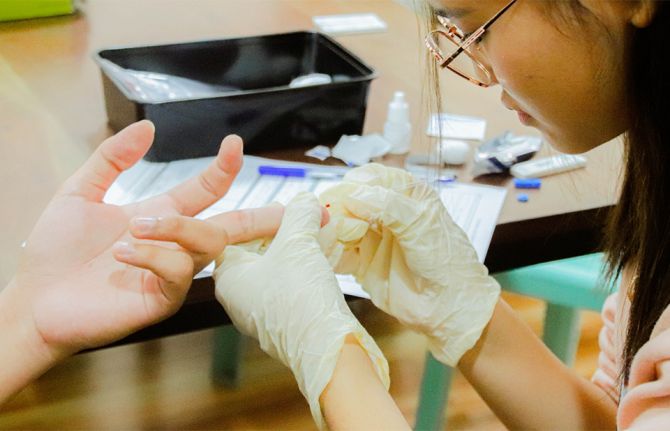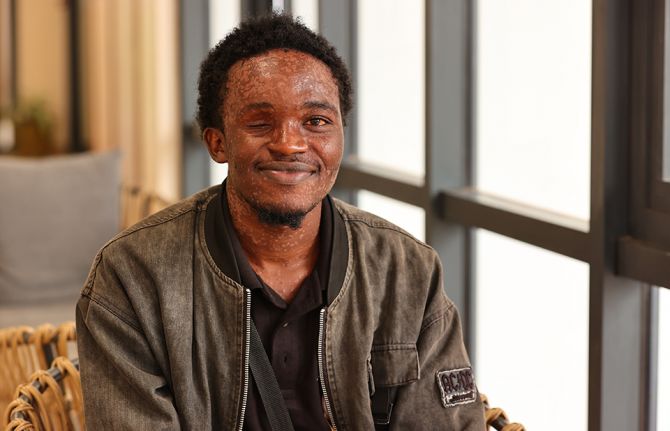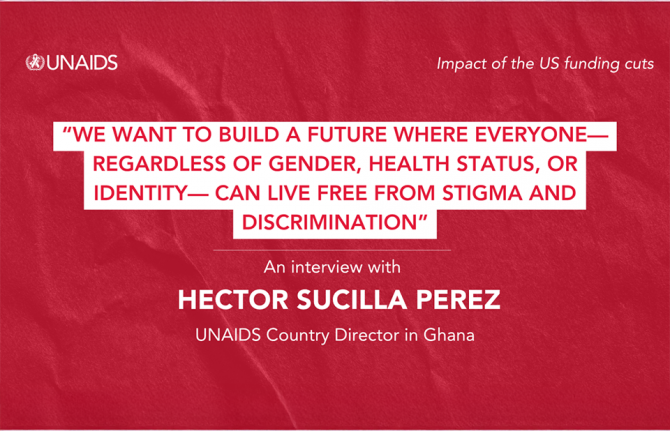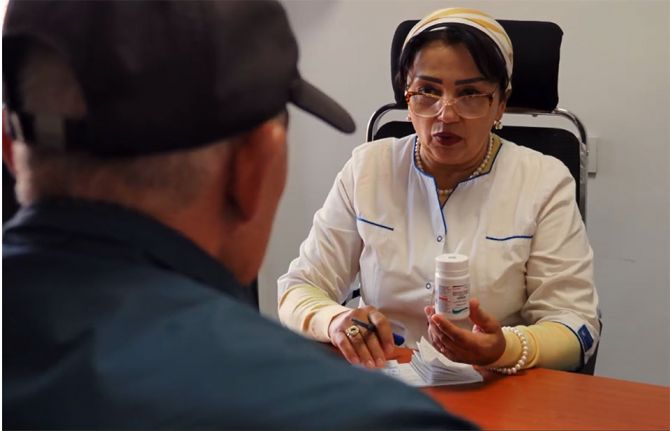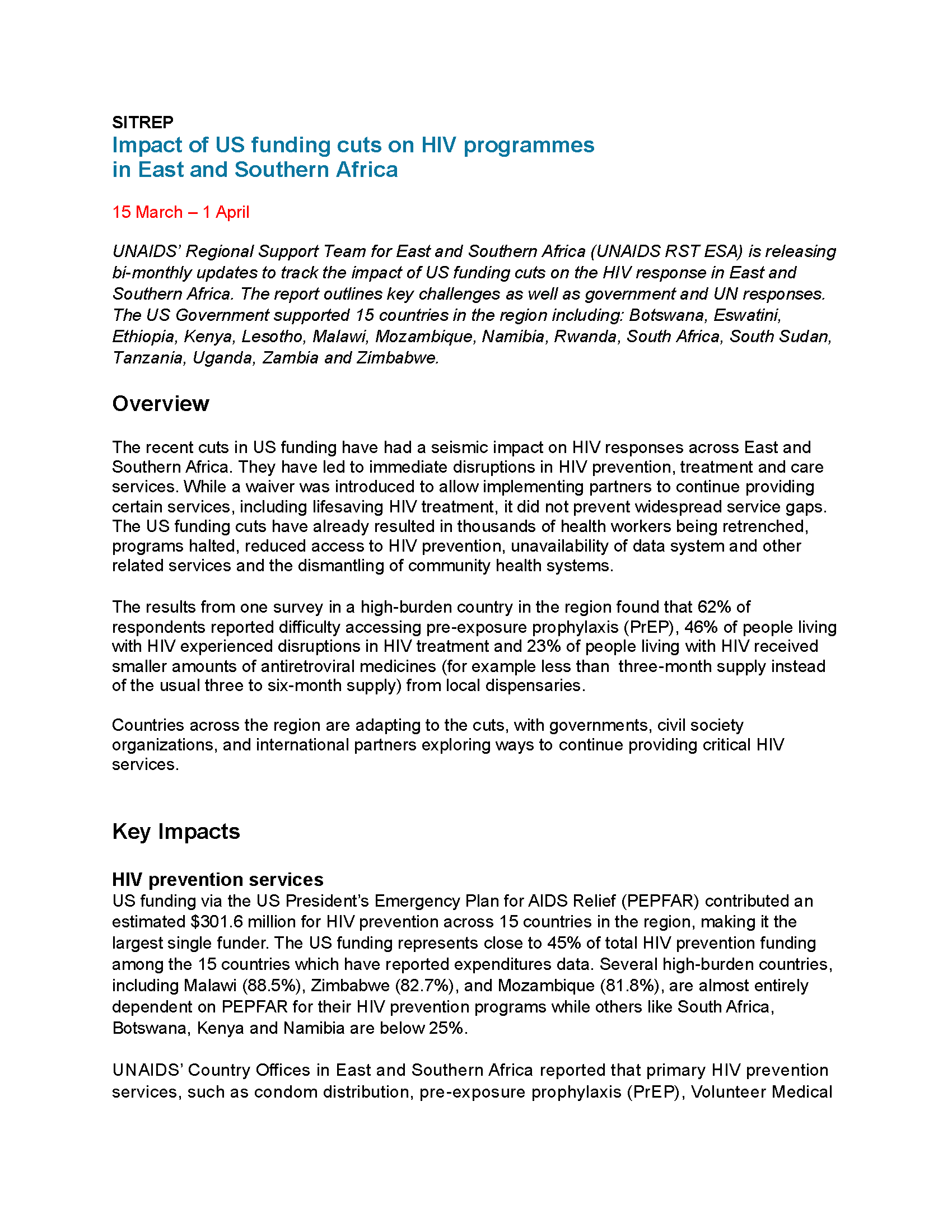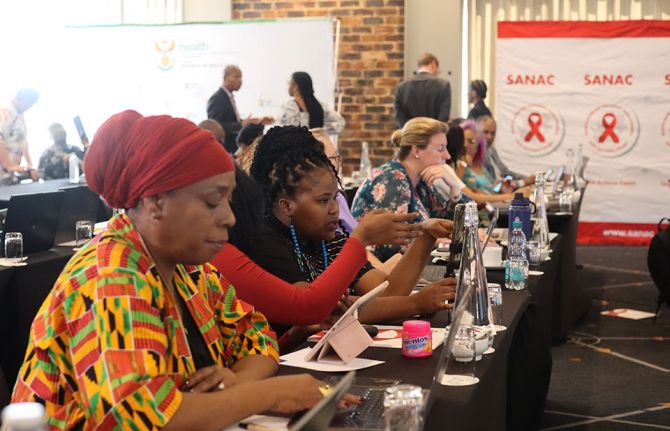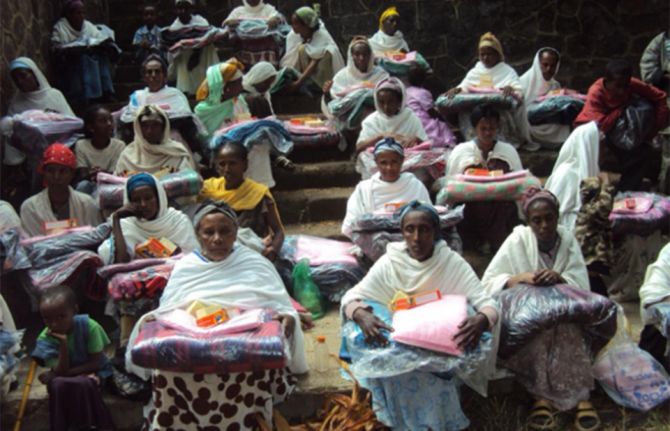
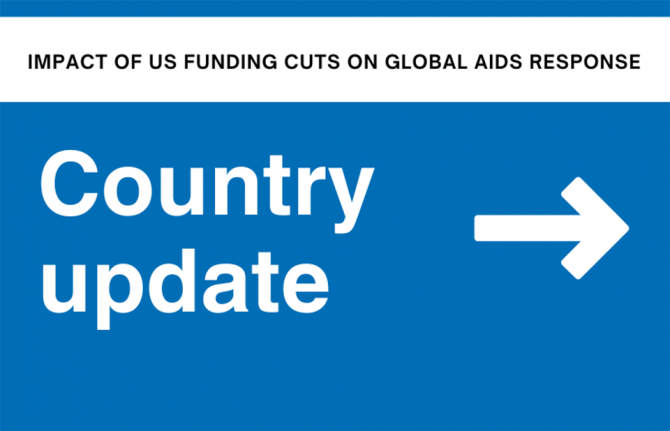
Feature Story
Impact of US funding cuts on HIV programmes in Togo
03 April 2025
03 April 2025 03 April 2025Immediate risks and disruptions
- Documented impact on services:
- Reduced availability of PrEP; suspension of HIV prevention education and awareness campaigns, and decreased access to HIV testing and counselling services for key populations.
- Disruption of the distribution of condoms, lubricating gel, antiretroviral drugs.
- All programmes on stigma and discrimination funded by the US Government have stopped.
- Disruption of HIV data collection:
- Cessation of data entry at PEPFAR sites, leading to a disruption in HIV data collection.
- Decrease in viral load testing:
- Viral load testing has decreased due to the slowdown in services at PEPFAR-funded sites.
- Stock concerns:
- Concerns about stock-out of HIV test kits within 3-6 months.
- Condom stocks are sufficient for 1-3 months; but there is a need for 800,000 condoms per month, with funding for procurement being a concern.
- International NGO-run services:
- All services run by international NGOs funded by US Government/PEPFAR have stopped.
Politically relevant updates
- Government actions:
- The National Programme for the Fight against HIV/AIDS and Sexually Transmitted Infections has conducted an analysis of service provision, commodity availability, and human resources.
- The National Council for the Fight against AIDS sent an information note to the President and the Ministry of Health.
- Advocacy efforts with other technical and financial partners to mobilize resources to fill gaps.
- Integration of HIV services into other health services is being worked on by the government.
- The government is funding 55 operational sites and 142 mediators.
- Civil society impact:
- Civil society has assessed financial, programmatic, and human resources gaps.
- Consultation meetings with the National Program for the Fight against HIV/AIDS and Sexually Transmitted Infections and implementation of a roadmap.
Impact
- Impact of USAID funding suspension:
- 11,000 people living with HIV will lose access to antiretroviral treatment.
- 24,769 people living with HIV will no longer have access to viral load testing.
- 10,000 individuals, including pregnant women and their children, will miss out on testing.
- 203 project staff are facing technical unemployment since January 2025.
- Current financial gaps:
- Togo faces a financial gap of 2.1 billion FCFA (West African CFA franc) for 2025, with 1.6 billion FCFA needed for antiretroviral medications and reagents.
- Proposed solutions:
- Increase the state budget line for health from 2.5 billion FCFA to 5 billion FCFA.
- Include HIV as a chronic disease in the universal health insurance mechanism to ensure sustainable domestic funding.
UN response
- The UNAIDS Country Office is meeting with networks of people living with HIV and key populations, and a country-level task team is in place, including representatives from people living with HIV and key population networks.
Related resources
Region/country
Related

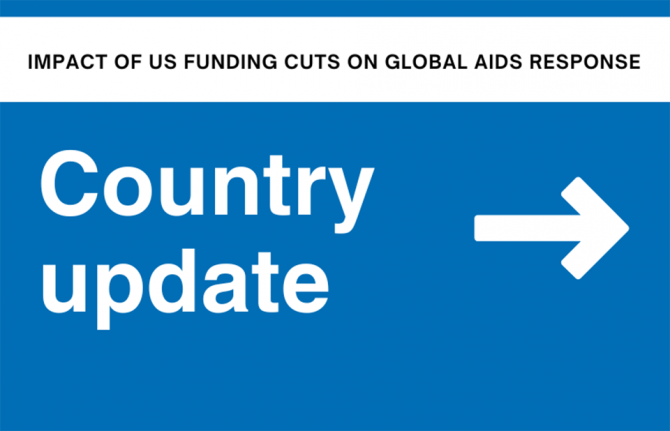
Feature Story
Impact of US funding cuts on HIV programmes in Burundi
02 April 2025
02 April 2025 02 April 2025Immediate Risks and Disruptions
- Funding Gap: An immediate input gap of 6,436,448 USD has been identified; these funds are required to cover the purchase of antiretroviral therapy (ARVs), tuberculosis (TB) prevention products, essential drugs for opportunistic infections (OIs), rapid tests, and transport costs.
- Service Disruptions: The US funding cuts have disrupted services provided by ICAP, a major implementing partner financed by the US, and its two main civil society organization sub-recipients, affecting approximately 10,290 people living with HIV (PLHIV), including 528 pregnant/breastfeeding women, and 5,512 people most at risk of exposure to HIV.
- Impact on Key Services: An evaluation carried out by the stakeholders estimated the impact of the US funding cuts as follows: Services impacted by more than 25% include: pre-exposure prophylaxis (PrEP), distribution of condoms and lubricants, health promotion and prevention services, services for key vulnerable populations (KVPs), prevention and management of sexual and gender-based violence (SGBV), community-led monitoring (CLM), and data management and health information systems.
Politically Relevant Updates
- Suspension of US Government Funding: the 90-freeze of US foreign assistance has put on hold at least 6,872,000 USD, representing support for more than 50% of the HIV activities needed to ensure continuity of service for people living with HIV.
- Impact on Data Management: The cuts have compromised data production and management, with over 711,500 USD needed to support the management of electronic medical record systems and the strengthening of the national health information system.
- Civil Society Impact: Community organizations involved into Community Led Monitoring (CLM) are heavily impacted, with three implementing partners (CAPES+, BUNERELA, CBF+) reporting a funding impact of 230,574 USD on their operating budget and on their human resources. Additionally, more than 167 staff from service provider organizations have had their contracts affected, and 30 peer educators working with 200 infected injecting drug users have had their contracts terminated.
The US funding cuts have had a profound impact on HIV programmes in Burundi. For example, ICAP, an implementing partner financed by the US, provided comprehensive coverage of prevention, treatment, and care as well as HIV viral load monitoring to around 61,000 PLHIV (out of an estimate of 81 000 PLHIV in the country) through the Baho Mbeho project in 349 health facilities across 18 provinces. The disruption of these services has left thousands of individuals without essential support, highlighting the critical need for sustained funding and international cooperation to ensure the continuity of HIV programmes.
Recommendations and mitigation measures resulting from consultations and an impact workshop include:
- Organize a joint field impact assessment mission under the lead of the Ministry of Health (MOH).
- Set up a crisis management group and a mitigation plan.
- Map US-funded interventions/projects.
- Set up a team to leverage the UNAIDS Rapid AIDS Financing Tool (RAFT).
- Model impact according to various scenarios and reprogram/reprioritize interventions.
- Meet with development partners to discuss funding and support.
- Include HIV in primary health care, universal health coverage (UHC), and social protection.
These measures aim to address the immediate risks and disruptions, ensuring that HIV programmes can continue to provide vital services to those in need.
Related resources
Region/country
Related

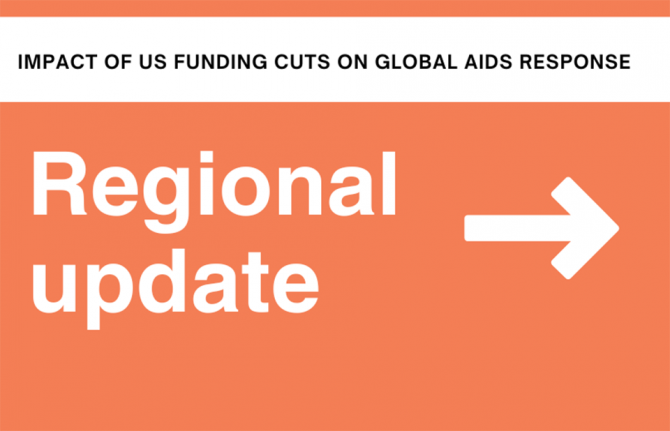
Feature Story
Communities in crisis: The collapse of HIV lifelines in Eastern Europe and Central Asia
01 April 2025
01 April 2025 01 April 2025A support group session for families with children living with HIV had just ended in Dushanbe, Tajikistan, when the news broke: the US Government announced a funding freeze. The room fell silent. For many participants, this group—run by the Tajikistan Network of Women Living with HIV—was their only source of psychological and social support and a vital, trusted bridge to lifesaving medical services. As the network is funded by the US, there was fear for its continued existence.
“People are panicking,” said Tahmina Haidarova, Head of the Tajikistan Network. “They fear that if our support services shut down, women affected by HIV, families with children living with HIV and people from key populations, including those newly diagnosed, will have nowhere to turn for support.”
This fear is now rippling across Eastern Europe and Central Asia (EECA), where community-led organizations and civil society initiatives remain heavily dependent on international funding, particularly from the Global Fund to Fight AIDS, Tuberculosis and Malaria and the US Government (which also funds the Global Fund).
In the majority of EECA countries, national governments do fund antiretroviral (ARV) medicines. However, the broader ecosystem essential to ensuring access to HIV services and treatment —including community outreach, counseling, HIV prevention, peer-led support, and human rights advocacy—has historically been deprioritized by governments and has never been fully institutionalized into national health systems.
This failure to reach people with existing services has led to a devastating outcome: only half of all people living with HIV in the region are on treatment and EECA remains the only region in the world where AIDS-related deaths continue to rise.
Across the region, many people affected by HIV and members of key populations actively avoid healthcare services due to fear of criminalization, stigma, and past experiences of discrimination. Without trusted community organizations to support and guide them, they fall through the cracks. In a region where 94% of new HIV infections occur among key populations and their partners, community-led support has been—and continues to be—essential.
“These services are not optional. They are the very foundation of an effective HIV response in a region where people are routinely excluded from healthcare due to criminalization, stigma, and discrimination,” said Vera Ilyenkova, UNAIDS Adviser on Key Populations and Community Engagement for the EECA region. “The process of building sustainable community-led services through national roadmaps and social contracting has only just begun. These fragile advances are now at serious risk.”
Ukraine, once a regional leader in transitioning from donor to domestic funding, has been forced to reverse course due to the war. The country has become heavily dependent on international assistance to sustain essential medical care, including HIV services. The US Government currently supports antiretroviral therapy (ART) for more than 117,000 HIV patients and pre-exposure prophylaxis (PrEP) for more than 13,000 people at high risk of HIV exposure in Ukraine. Although ART supply continuity has been confirmed, the wider impact of reduced funding is already being felt. '100 Percent Life'—the largest network of people living with HIV in the country—expects to lose a quarter of its workforce, and a critical situation has arisen regarding the availability of PrEP medications. The supply of antiretrovirals for PrEP, funded by the US Government, has been cancelled.
In Kazakhstan, the US Government supported peer-led services, HIV prevention programs, and professional training in two regions are now under threat. In Tajikistan, US funding enabled the expansion of HIV testing, access to PrEP, and essential services provided by civil society groups to communities that would otherwise remain invisible to the healthcare system.
Although Uzbekistan did not receive direct US Government funding for HIV-related programs, critical initiatives such as civic space development, education, and HIV advocacy were supported by US assistance. With these programs now closed, organizations working on HIV-related legal reforms, anti-discrimination efforts, and rights-based healthcare access are facing increased challenges in continuing their work and advocating for policy change.
The US funding cuts have also significantly impacted regional community networks and multi-country initiatives doing regional advocacy. Collective efforts in harm reduction, HIV decriminalization, and legal reform across EECA are now struggling to survive. Several organizations that have played pivotal roles in shaping inclusive, human rights-based responses to HIV are facing critical funding cuts and may be forced to shut down entirely by mid-2025.
“This is not just a financial crisis,” said Ganna Dovbakh from the Eurasian Harm Reduction Association. “It is a crisis of global values and priorities. Right now, the future of our dignity, health, and human rights is uncertain. Community organizations are the first responders in this crisis—yet they’re being forced to survive without oxygen, and preferably in silence.”
Emergency mitigation measures are underway, including the reprogramming of international funds and new partnerships—such as emergency support from the Deutsche AIDS Stiftung for grassroots organizations in Ukraine and Tajikistan—but these are stopgap solutions. They cannot replace long-term, strategic investment.
“We call on donors to ensure emergency support for these organizations; on governments to integrate and co-finance community services as part of national health strategies; and on international partners to continue pushing for inclusive, rights-based responses to HIV that leave no one behind,” said Eamonn Murphy, UNAIDS Regional Director for Asia Pacific and Eastern Europe and Central Asia.
Because without communities at the center, there is no response—and no hope of ending AIDS.
Region/country
Related
 Women, HIV, and war: a triple burden
Women, HIV, and war: a triple burden

12 September 2025
 Displacement and HIV: doubly vulnerable in Ukraine
Displacement and HIV: doubly vulnerable in Ukraine

11 August 2025


Feature Story
Impact of US funding cuts on HIV programmes in Kenya
01 April 2025
01 April 2025 01 April 2025Since the US cut their foreign assistance, the Government of Kenya has provided leadership to ensure continuity of HIV care at various levels, in consultation with different partners. Recently, the Ministry of Health, led by the Cabinet Secretary, convened high-level meetings with County Governors, the parliamentary Health Committee, Development Partners for Health and communities to discuss the impact of the US funding cuts and make recommendations.
In the meetings, the following were agreed/discussed:
- Establishment of a multi-sectoral monitoring and coordination committee to regularly monitor the impact and manage information and communication
- Seek emergency access to HIV/TB/Malaria commodities in-country and information on orders in high seas and manufacturers
- Seek emergency financing for identified gaps in commodities and HRH
- Mobilize county governments for re-purposing of entire health workforce to mitigate HIV/TB/Malaria service gaps and community initiatives
- Propose policy actions for Health Systems Resilience in the face of dwindling aid-based development funding for healthcare
- Seek consensus for policy reviews and pathways for mainstreaming and integration of vertically funded programs into public health service delivery mechanisms
Service Delivery
The country has witnessed resumption of HIV prevention and treatment services, however not at full scale. For instance, community prevention and treatment services such as community outreach services, peer led awareness and education and differentiated service delivery have been impacted. Additionally, sample networking for viral load testing and early infant diagnosis remains impacted.
Due to the unstructured and abrupt nature of the integration of HIV services into outpatient clinics, there have been reports of incidences of stigma and discrimination towards people living with HIV and key populations including fears of involuntary disclosure and lack of confidentiality.
Supply Chain Management System
The Government has assured it has adequate stocks of HIV health products and technologies in the country. The commodities that were running low at health facility level were flagged off for distribution by the CS Ministry of Health through USAID supported procurement agency (MEDS). The consignment included antiretroviral drugs, HIV testing kits, male condoms, early infant diagnosis and viral load testing reagents.
Strategic Information
The Kenya Health Information System (KHIS) that captures national aggregate HIV program data has been down due to the US funding cuts. This has hampered the availability of data for program reporting and other reporting processes, including GAM and mini-GAM (HIV services monthly reporting).
Civil Society and Communities’ Impact, Resilience, and Response
- Civil society and communities continue to convene to discuss the impact and develop mitigation strategies.
- Communities of PLHIV and Key populations, through their formal and informal networks, are offering peer led services such as counselling, treatment information, peer referrals and linkages to address the gaps.
- They have also led high level advocacy with the media that has influenced government decisions to address the impact of the Stop work order.
- Communities and Civil Society have played a key role in providing useful information, including lived experiences on the impact of the funding and services interruptions, that have been used by the international community to advocate for continued support by US Government.
- Communities have widened their resource mobilization efforts from non-traditional donors to sustain their initiatives that have been impacted by the Stop Work Order
UN Response
- UNAIDS is supporting communities in analysis and review of the community-led assessment tool to assess the impact of the funding disruptions on delivery of services.
- UNAIDS convened communities and civil society to discuss the funding disruptions and develop mitigation measures. The outcome of the meeting has led to the advocacy for the domestic funding and media engagements to influence actions by governments to bridge the gaps in HIV services as a result of the US funding cuts.
- UNAIDS provides technical assistance to communities and civil society on advocacy efforts as well sustaining interventions that have been impacted by the US funding cuts.
- UNAIDS supported the creation of compelling outputs from GOALS modeling to demonstrate the impact of funding shifts on new HIV infections and mortality based on prevention and treatment coverage scenarios which could result from the funding shifts. These outputs will be used to supplement ongoing advocacy efforts.
- Some of the UN agencies have initiated joint programing through co-funding initiatives to mitigate the impact of the US funding cuts.
Related resources
Region/country
Related


Feature Story
Impact of US funding cuts on HIV programmes in East and Southern Africa
31 March 2025
31 March 2025 31 March 2025UNAIDS’ Regional Support Team for East and Southern Africa (UNAIDS RST ESA) is releasing bi-monthly updates to track the impact of US funding cuts on the HIV response in East and Southern Africa. The report outlines key challenges as well as government and UN responses. The US Government supported 15 countries in the region including: Botswana, Eswatini, Ethiopia, Kenya, Lesotho, Malawi, Mozambique, Namibia, Rwanda, South Africa, South Sudan, Tanzania, Uganda, Zambia and Zimbabwe.
The recent cuts in US funding have had a seismic impact on HIV responses across East and Southern Africa. They have led to immediate disruptions in HIV prevention, treatment and care services. While a waiver was introduced to allow implementing partners to continue providing certain services, including lifesaving HIV treatment, it did not prevent widespread service gaps. The US funding cuts have already resulted in thousands of health workers being retrenched, programs halted, reduced access to HIV prevention, unavailability of data system and other related services and the dismantling of community health systems.
The results from one survey in a high-burden country in the region found that 62% of respondents reported difficulty accessing pre-exposure prophylaxis (PrEP), 46% of people living with HIV experienced disruptions in HIV treatment and 23% of people living with HIV received smaller amounts of antiretroviral medicines (for example less than three-month supply instead of the usual three to six-month supply) from local dispensaries.
Countries across the region are adapting to the cuts, with governments, civil society organizations, and international partners exploring ways to continue providing critical HIV services.
Key Impacts
HIV prevention services
US funding via the US President’s Emergency Plan for AIDS Relief (PEPFAR) contributed an estimated $301.6 million for HIV prevention across 15 countries in the region, making it the largest single funder. The US funding represents close to 45% of total HIV prevention funding among the 15 countries which have reported expenditures data. Several high-burden countries, including Malawi (88.5%), Zimbabwe (82.7%), and Mozambique (81.8%), are almost entirely dependent on PEPFAR for their HIV prevention programs while others like South Africa, Botswana, Kenya and Namibia are below 25%.
UNAIDS’ Country Offices in East and Southern Africa reported that primary HIV prevention services, such as condom distribution, pre-exposure prophylaxis (PrEP), Volunteer Medical Male Circumcisions (VMMC) and peer outreach conducted by community-led organizations have been deeply affected by US funding cuts. PrEP services are particularly impacted due to their heavy reliance on US funding. The DREAMS programme, which targeted 2 million adolescent girls and young women in 10 countries in the region has shut down. Similarly, programming for key populations, including HIV prevention programming, has not been prioritized.
Notable examples:
- In Malawi HIV prevention education and awareness campaigns and VMMC services have been suspended or reduced. Community-based HIV prevention and outreach programmes have been disrupted. Recent efforts to develop a national programme for people who use drugs have been affected. Programs for key populations have been significantly affected, with the closure of drop-in centers.
- The DREAMS programme in all 10 countries has halted. The programme was a PEPFAR initiative that served 2 million adolescent girls and young women in sub-Saharan Africa and focused on HIV prevention, sexual and reproductive health and rights, physical and sexual violence, education and empowerment.
HIV treatment and preventing vertical transmission of HIV
The US funding cuts have caused widespread fear and confusion about treatment availability, particularly among people living with HIV who access HIV related services in drop-in centers. Despite the waiver, services for pregnant women living with HIV have been affected, increasing the risk of vertical transmission during childbirth and breastfeeding.
Notable examples:
- In Kenya, some HIV treatment facilities are not yet operating optimally due to staffing challenges, which has resulted in unguided integration of HIV into outpatient services, posing a threat to patient privacy. Additionally, panic about treatment availability, particularly among young people living with HIV, has led to some young people living with HIV spacing, sharing and/or stockpiling antiretrovirals (ARVs).
- Zimbabwe has experienced disruptions in testing of pregnant women during prenatal care, early infant diagnosis, pediatric HIV treatment services and the sample transport system.
Health facility closures and disruptions in clinical services
Countries have reported closures of some sites delivering HIV treatment or other disruptions in clinical HIV services. Thousands of health workers have been retrenched leading to major service disruptions. In some cases, health workers without prior experience in HIV care have stepped in raising concerns about the quality of care.
Notable Example :
In Kenya approximately 41,000 doctors, nurses, technical and management staff and community workers were supported by the US government; in South Africa 15,000 health workers; in Mozambique more than 21,000 health workers.
- In Malawi 247 nurses, 3,513 community health workers, 206 technical and managerial staff and other 485 human resources reliant on US funding are facing contract terminations. Furthermore, HIV data management has been hugely affected; 20% of the 271 electronic medical record systems established at service sites were down during assessments in February.
- In Ethiopia, there is currently no plan by the government or partners to take in the human resource costs caused by the US funding cuts namely the jobs of 97 community adherence case managers, 194 support workers, eight pharmacy technicians and six laboratory technicians for HIV treatment services.
Community health systems
There is concern that community systems, including advocacy, service delivery, monitoring, and evidence gathering, are collapsing. In several instances, even where governments step in to fund treatment gaps, most resources are directed toward formal health systems, leaving community-based initiatives behind.
Notable examples:
- In Angola, all community outreach programmes supported by PEPFAR in four of the country’s 21 provinces have stopped.
- In Eswatini, many community-led or peer-led facilities and services, as well as services provided by local and international NGOs, have stopped functioning.
Key populations and human rights
US funding has been largely halted for projects and programmes focused on addressing stigma and discrimination and enabling legal environments. This often means that monitoring of human rights issues has stopped, intensifying fears of discrimination and human rights violations against people living with HIV and key populations and other vulnerable groups as they are forced to switch from tailored, community-supported services to government services for the general population. In resource-constrained regional settings, there is a risk that programming for key populations, including HIV prevention and care linkages, will not be prioritized.
- There are growing challenges to accessing HIV prevention and sexual and reproductive health rights services for adolescent girls and young women given the defunding of HIV prevention services including youth friendly services at community level.
- Across East and Southern Africa, funding for gender-based violence prevention and response programs are coming to a halt.
Research and trials
In South Africa, US government-supported research on the HIV vaccine and long-acting PrEP has come to a halt. A large tuberculosis (TB) research study was also stopped leading to fears of disruptions of TB service delivery, reductions in treatment adherence and increases in TB transmission and mortality. In Ethiopia, the US government supported Cab-La pilot has halted. Thisnew HIV prevention technology would especially benefit adolescent girls and young women who face inequalities that create barriers to accessing sexual and reproductive health services.
Government responses
Countries in the region are responding to the impact of the funding cuts on their HIV response. Many countries conducted UNAIDS-supported rapid surveys to assess the impact of the cuts on recipients of HIV services and have put in place short and long-term mitigation measures. Kenya and Rwanda are among the list of countries that have reported that domestic resources are being mobilized to maintain priority HIV programmes previously funded by the US. Countries have committed to ensuring continuity of treatment for people living with HIV and are discussing future budgetary allocations for antiretroviral treatment to ensure there are no disruptions in ARV medications.
Notable examples:
- Ethiopia’s parliament has introduced a new payroll tax as part of measures to fill the financial gap left by the USAID funding pause. The new bill has been forwarded to a parliamentary committee for deliberation. The funds collected will go to a new Ethiopian Disaster Risk Response Fund to pay for projects previously funded by USAID including HIV medication.
- In Lesotho, a task team has proposed mitigation measures based on a mapping of US-funded projects, including government payment of salaries for affected staff, task shifting, recalling of staff on leave, and integration of HIV services.
- Botswana and South Africa are among those countries working with organizations that have lost US funding to refer their clients to government facilities for essential services.
- Malawi's government is working with partners, including UNAIDS, to ensure the continuation of HIV services and plans to lead service delivery planning and management going forward, with partners supporting where gaps are identified.
Critical gaps
The recent US funding cuts have created critical gaps in the HIV response across East and Southern Africa. The gaps, unless filled, will have severe public health consequences, reversing the gains made thus far in the HIV response.
Key areas affected:
HIV prevention & treatment commodities: Reduced access to ART, HIV test kits, PrEP and condoms, increasing the risk of HIV transmission and HIV treatment interruptions.
Human resources for health: Workforce shortages due to salary cuts and hiring freezes which is putting a service delivery and patient care.
TB Ccmmodities: Limited availability of diagnostic tools and TB medications, delaying detection and treatment, which could lead to drug resistance.
Data monitoring & management systems: Weakened tracking of disease trends, leading to gaps in evidence-based HIV response planning.
Community systems: Closing of community-led health initiatives, outreach programs and peer support has disrupted community systems that are vital to the success of the HIV response.
UNAIDS response
- Monitoring and communication: UNAIDS regional team is actively monitoring the impact on the response in the region and supporting organization wide efforts to collect data and information on the impact in real time. The regional team is maintaining communication and collaboration with communities, networks and partners.
- Collaborative assessments: UNAIDS regional team has been supporting UNAIDS Country Offices as they work with governments to assess the impact of the HIV response and to put in short- and long-term mitigation measures.
Collaborations with communities: UNAIDS is collaborating with the Athena Network on assessing the impact of the funding cuts on girls and young women. UNAIDS is also working with the Global Network of People Living with HIV (GNP+) to develop a comprehensive survey to document the impact on community systems across the region.
- Collaboration with regional co-sponsors: UNAIDS, UNICEF and WHO are in discussions about the impact of the US funding cuts on supply chain constraints and collaborating on potential solutions for the region. UNAIDS and WHO are engaging with national AIDS commissions to assess the impact and discuss fundraising modalities to continue ongoing HIV related activities. Through the 2gether4SRHR program, collaborations between UNICEF, UNFPA, WHO and UNAIDS at both country and regional level are reviewing plans to be more responsive to the current crisis. Efforts are underway to collect data, identify effective integration models and establish a minimum HIV service package for humanitarian settings.
- Support for transitioning to national ownership: The UNAIDS regional team is working in collaboration with the SADC Secretariat and member states on the sustainability roadmaps. UNAIDS is working with UNAIDS Country Directors to advance HIV Sustainability Roadmap Part B with support from Gates Foundation and Global Fund in Namibia, Botswana, Malawi, Kenya, Zambia and Zimbabwe. UNAIDS also socialized UNAIDS Country Directors on the RAFT Tool, which helps countries assess PEPFAR investments and prioritize necessary actions to address these. The tool has been piloted in Uganda and Rwanda and is now being rolled out more broadly.


Feature Story
Impact of US funding cuts on HIV programmes in El Salvador
28 March 2025
28 March 2025 28 March 2025Immediate Risks or Disruptions
- Stockouts:
- Pre-Exposure Prophylaxis (PrEP): The HIV Program Unit of the Ministry of Health has only a four-month supply of PrEP remaining. However, The Global Fund authorized them to use remaining funds to purchase PrEP.
- The USAID PASMO project, which implemented PrEP through private clinics, has not returned; they have only been authorized to work on offering self-testing.
- Service Capacity:
- HIV Testing & Treatment: antiretroviral therapy provision continues, but facilities are operating at reduced capacity.
- HIV Prevention Services: Reduced capacity is affecting key populations such as gay men, sex workers, people who use drugs, and transgender people.
- At the moment, the greatest impact is on prevention, as only 11 of the 30 promoters who supported doctors in initiating PrEP for key population users in the VICITS clinics have been rehired. Therefore, their workload has been overloaded by assigning them three VICITS clinics per promoter.
- Comprehensive HIV Care Clinics: Projects supporting 20 out of 24 clinics were reinstated, allowing the return of 90% staff, including doctors, laboratory staff, pharmacies, data entry clerks, and community liaisons. The care and treatment areas are recovering despite the impact of the three-week pause that led to more than 1,200 antiretroviral therapy dropouts.
- Human rights, key and vulnerable populations: All programs on stigma and discrimination have stopped affecting key populations, adolescent girls and young women, and people living with HIV.
- Civil Society Organizations (CLOs):
- CLOs are experiencing significant challenges, including service reductions or suspensions, staff losses, and funding cuts, which limit their ability to advocate for key issues. Additionally, their capacity to collect and report data has decreased due to a lack of funding for monitoring activities. As a result, many CLOs face the risk of closure or severe reductions in services.
Politically Relevant Updates
- Government and UN Coordination:
- UNAIDS conducted an early assessment and has been continuously updating it, presenting the impact to the UN country team.
- A country-level task team is in place, with representation from REDSAL (a network of people living with HIV) and Colectivo Alejandría (representing key populations).
- Funding and Support:
- The USAID Global Health Supply Chain Program Procurement and Supply Management (PSM) resumed operations, providing support for supply chain projections and management.
- The Data for Implementation (DATA.FI), funded by USAID in collaboration with Palladium and the Department of Epidemiology at Johns Hopkins returned to assist with data analysis in the case registration system.
Related resources
Region/country
Related


Feature Story
Impact of US funding cuts on HIV programmes in Panama
28 March 2025
28 March 2025 28 March 2025Immediate Risks and Disruptions
PEPFAR Programme Delays:
- PEPFAR PrEP delivery to 2,500 people among key populations, mainly men who have sex with men, was canceled. However, as of 14 March PrEP provision services for key populations (MSM mainly) have been re-established and the MoH has taken over distribution.
- Human resources and transport for viral load samples at ARV clinics provided by PEPFAR were canceled, affecting several cities:
- Panama City: 8,100 people
- Colón: 1,300 people
- Pacora: 300 people
- Ngäbe-Buglé population: 1,400 people, where HIV prevalence is high.
- HIV commodities: Stocks available with minimal disruption.
- Prevention of vertical transmission (PVT) and pediatric HIV services: No services affected.
- HIV prevention: Disruptions in access, reduced capacity for HIV prevention services, including HIV counseling and testing, primarily affecting sex workers, men who have sex with men, and transgender people.
- Condom promotion and demand generation activities: Impact noted on public sector, social marketing programs, NGOs, and community distribution.
- Data collection: Continues at some facilities and service points, along with some data quality control and collation.
- Study suspension: The suspension of a study on recent HIV diagnoses and the halt in laboratory sample transportation have further limited essential diagnostic and monitoring services
- All programs on stigma and discrimination have stopped, affecting key populations. Communities have collected data on human rights issues, including increased stigma and discrimination.
- Disruptions noted in HIV prevention programs affecting particularly men who have sex with men, sex workers and transgender people
- Human resources and transport for viral load samples at ARV clinics provided by PEPFAR were canceled, affecting several cities:
Service Disruptions:
Politically Relevant Updates
- Government Actions:
- The Panamanian government began expanding friendly services to key populations to absorb the demand for PrEP that US funding was covering.
- Adjustments were made to ARV services to temporarily cover the human resources provided by US funding, however, this impacted the quality and timeliness of service provision.
- Civil Society Impact:
- Community-based organizations (CLOs) are struggling but have alternative funding sources; however, they have noted a reduced ability to participate in policy discussions.
- UN Response:
- A country-level task team has been established but does not include representatives from people living with HIV and key population networks.
- UNAIDS is collecting information from PEPFAR partners but has not received clear responses due to canceled field worker contracts.
Related resources
Region/country
Related


Feature Story
Impact of US funding cuts on HIV programmes in Myanmar
28 March 2025
28 March 2025 28 March 2025Immediate Risks and Disruptions
- Service Closures: US-supported facilities and international NGO-run services have shut down. Some antiretroviral therapy service facilities have closed, and there is no clear referral system in place.
- Supply Chain: antiretroviral supplies, HIV test kits, viral load tests, other lab tests, and male and female condoms are available with minimal disruption to distribution. However, condom stock levels are unavailable or not tracked.
- Service Disruptions: PrEP and HIV testing services have been disrupted. Prevention of vertical transmission and pediatric HIV services remain unaffected.
Civil Society Impact and Response
- CLOs: Community-led organizations (CLOs) face a reduction or suspension of services and have limited ability to advocate for key issues. Despite struggles, some CLOs have alternative funding sources.
UN Response
- Mitigation Actions: The UN country team has been engaged in actions to mitigate the impact of the USG shift. UNAIDS coordinated PEPFAR implementing partners to assess the impact.
Related resources
Region/country
Related


Feature Story
Impact of US funding cuts on HIV programmes in Nigeria
27 March 2025
27 March 2025 27 March 2025Stock Levels and Immediate Risks
- Stock Levels: A recent national stock-level assessment indicates that there are at least two months of stock at facilities and five months at central warehouses. This is consistent with normal operations, and no immediate risk of stockouts is anticipated. New shipments are expected in April.
- Service Disruptions: Some communities-based service delivery points are facing serious service interruptions, and there are currently no plans for referrals to other facilities. . Community HIV testing for the general population and key populations (KPs) has been significantly impacted due to disruptions in the community health workforce. Specialized wraparound services at over 80 One-Stop Shops have been disrupted in one way or another due to funding freezes. Disruptions in services for orphans and vulnerable children (OVC) may impact children living with HIV.
Relevant Updates
- Government Actions: The Nigerian government has taken proactive steps to address potential AIDS funding gaps, particularly in response to the suspension of US-funded programs. The Federal Executive Council (FEC) has approved N4.8 billion for procuring 150,000 HIV treatment packs under the 2024/2025 HIV Program Alignment. The government is also strengthening national systems, securing local financing, and engaging the private sector, including plans to establish an AIDS Trust Fund.
- Healthcare Workforce: The Government is collecting information about the health care workers that have been impacted by the funding freeze, with the intention to determine the critical number and skillset of workers in each state to be recommended for absorption into the public health workforce. One of the states, Rivers State, recently recruited 1,000 healthcare workers, absorbing some who were affected by the funding freeze. The Network of people living with HIV is leading efforts to map the impact on the community health workforce, with a Ministerial Task Team reviewing findings and proposing state-level interventions.
- Community and Civil Society Response: Community-led and peer-led services is mostly supported through the Global Fund and has continued, those PEPFAR-funded components have been interrupted due to "stop-work" orders issued to PEPFAR Implementing Partners. Many partners have yet to communicate updates to community workers, despite directives in the February 4th Memo from the US Government. Some implementing partners, such as Heartland Alliance, which supported over 20 One-Stop Shops for Key Populations, have received official contract termination notices from USAID, with no clear transition plan for their services.
- Resilience and Adaptation: Despite these challenges, the community and civil society organizations have shown resilience. For example, about two-thirds of community workers who received "stop-work" orders in January/Early February have been recalled following the February 4th Waiver Memo from GHSD. Additionally, national acceleration efforts to prevent vertical transmission of HIV continue to scale up across all states under Global Fund funding, relying on public health institutions and Global Fund-supported community health workers.
Summary of Key Assessment Findings
The task team has been meeting at the governmental level, with UNAIDS supporting the Federal Ministry of Health and the National AIDS Council DG, who co-chairs the task team.
Summary of key assessment findings:
- Community Workforce: Over 95% of community workers received "stop-work" orders, but about two-thirds have been recalled.
- ARV Access: Immediate access to antiretrovirals remains stable but testing and case-finding activities have stalled significantly. Investments by the Government of Nigeria and the Global Fund in the National PMTCT Acceleration Plan has however supported continued scale-up of PMTCT testing and treatment.
- ARV Stock Pipeline: The pipeline for 1st-line ARVs remains strong, with over six months of stock available. New shipments are expected to continue, but distribution challenges may arise.
Crisis Response Plan: The newly inaugurated AIDS, TB and Malaria TWG, has been tasked to leading the convening of critical stakeholders to set-up crisis response plans at national and sub-national level, with clear communications channels for reporting service delivery disruptions. The committee has conducted a preliminary gaps analysis which informed the approval of a supplementary budget of about $200 million.
Related resources
Region/country
Related


Feature Story
Impact of US funding cuts on HIV programmes in Malawi
27 March 2025
27 March 2025 27 March 2025Immediate Risks and Disruptions
A full resumption of HIV services is required for the effective delivery of HIV prevention services. HIV services are dependent, and different parts of the U.S. Government fund different components —for example, the Centers for Disease Control and Prevention funds HIV treatment - which received a partial waiver to continue - and USAID funds the supply chain. Partners funded by USAID received stop work orders, halting the flow of essential HIV treatment commodities and impacting the delivery of HIV treatment and prevention services. Partial waivers block the delivery of services.
The country has 37,000 vials of cabotegravir long acting injectables expiring in May 2026. A further 30,000 vials purchased under the Global Fund to Fight AIDS, Tuberculosis and Malaria will arrive in Malawi in June 2025 to support the scale-up of injectable PrEP. To absorb the gap in the program created by U.S. funding cuts to the partner supporting this activity, the government has instructed the remaining implementer to continue with the scaling up of injectable PrEP focusing on people continuing PrEP and only recruit new pregnant and lactating women. However, the absence of implementing partners and the limit to recruit only continuing clients and pregnant and lactating women may not generate sufficient the client load risking the long acting injectables expiring. A resumption of the program to recruit on the full spectrum of eligible people into the program is required.
- Human Resources:
- Contract Terminations: More than 4,500 staff including 247 nurses, 1,642 Health Diagnostic Assistants, 1,871 treatment supporters, data clerks and others supported by U.S. funding have had their contracts terminated. The exact numbers of staff impacted are difficult to quantify because of the stop-and -resume flow of human resources based on the stop-resume-stop implementation of the waivers.
- Reduced Capacity: Although the government of Malawi has rationalized the continuation of services and deployed staff to fill the gaps created by the stop order and waiver, HIV services are yet to recover fully. Facilities providing prevention of vertical transmission of HIV, early infant diagnosis (EID), pediatric and adult HIV treatment services are operating at reduced capacity. Community-led monitoring and other activities led by civil society have reduced. Only community-led activities supported by the GFATM are continuing, helping fill the gap in the availability of HIV services
- Outreach Services: Outreach services, especially those targeting key populations, adolescent girls and young women, refugees and displaced people, have been affected, impacting prevention and treatment services and may lead to increased antiretroviral therapy default rates and new HIV infection.
- Service Provision:
- Facility Closures: Some facilities providing Antiretroviral Therapy (ART), especially the 18 drop-in centers serving more than 7,000 key populations living with HIV have reduced their operations and referred the people to to other facilities. Crowds of patients waiting for services typical of non-HIV services are now common in the HIV treatment section.
- Testing Services: DNA-PCR testing for HIV Exposed Infants (HEI) will continue only at sites with point-of-care testing capacity. Other infants will be tested at 12 and 24 months using Rapid Diagnostic Tests (RDT).
- Targeted viral load sample testing will take place in sites with point-of-care capacity. new HIV infections, with poor EID service, new HIV infections among children are likely to increase.
- Supply chain and sample Transportation: The sample transportation system has been suspended. Although the government redeployed ambulances to transport samples, hundreds of thousands of samples remain stuck and unusable, A million HIV test kits risk expiring, without a revitalized HIV testing drive using local staff. Although implementing partners leading work on voluntary medical male circumcision (VMMC) received partial waivers to continue VMMC. Without a full resumption of the program, the VMMC faces an imminent stop in a month because the supplies are limited.
- Commodity Stock Levels:
- ARV Supplies: Stocks of antiretroviral (ARV) supplies, HIV, viral load (VL) and other lab test kits, and condoms are available with minimum disruption. However, dispensing of ARV emergency supplies has been suspended to avoid panic refills and depleting stocks.
- Condom Stock Levels: Sufficient for the next 12 months, but non-facility condom programming has stopped.
- Impact on Specific Populations:
- Adolescent Girls and Young Women (AGYW): Reduced capacity for HIV prevention services, including PrEP, testing, and outreach programs. Malawi has 2,341,000 AGYW of which 2.4% are living with HIV. 25% of new HIV infections are among AGYW. Programs for orphans and vulnerable children have completely stopped and are not included the prioritization of HIV services.
- Key Populations (KPs): HIV prevention services for KPs have also been impacted. This includes continuation of provision of oral PrEP where human resources are available, and continuation of only old clients on injectable PrEP. Discontinuation of hepatitis B testing except in antenatal care and inpatient care. The Government with implementing partners support 18 Drop-in Centers spread across in Blantyre, Mangochi, Muzuzu and Lilongwe are devising a plan to keep the dropping centres. The centres cater to key populations with a total cohort of 7,600 people living with HIV accessing HIV treatment and 7,000 continuing PrEP.
Politically Relevant Updates
- Government Actions:
- Task Team: A country-level task team has been convened to discuss the impact on service delivery and identify mitigation measures. This includes representatives from people living with HIV and key population networks.
- Mitigation actions by government and country partners include expanded community health worker or peer-led health services and integration of HIV services into other health services.
- Transitional Plan: The government is developing a plan for HIV commodities warehousing and distribution to transition from the current service provider to the Central Medical Stores Trust.
- Civil Society Impact:
- Community-Led Organizations (CLOs): CLOs are at risk of closure or severe reduction in services due to funding cuts. This affects their ability to deliver services, advocate for key issues, and participate in policy discussions.

